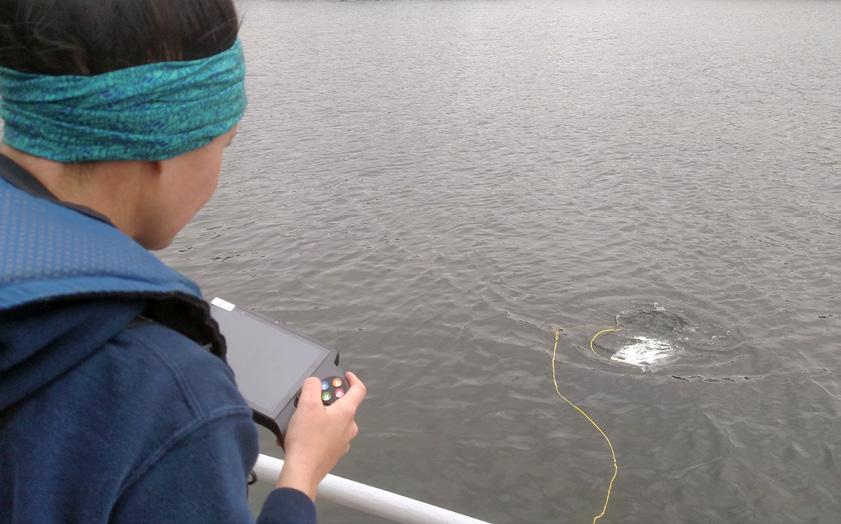
4 minute read
UAPB Specialists Work to Restore Aquatic Vegetation at DeGray Lake
Traditional and down-imaging sonar images of coontail, left, with actual coontail collected by a weed collection rake from the same location at DeGray Lake, right.
Faculty and staff at the UAPB Department of Aquaculture and Fisheries continue to make progress on a number of research projects that benefit the university’s partners and the Arkansas public. As part of one ongoing initiative, Scott Jones, small impoundment Extension specialist, has been poring over recent video footage shot with a submersible drone in the depths of DeGray Lake, located in southwest Arkansas in the Ouachita Mountains foothills.
Advertisement
Jones said the recording documents his attempts in getting familiar with operating the new underwater drone technology. The video takes viewers on a journey from over the side of a boat, through surface waters and down to the lakebed.
“We travel through a plethora of aquatic plants and past obstacles such as submerged logs,” Jones said. “Gliding over carpets of macroalgae, we encounter species such as black bass, suckers, catfish and turtles along the way.”
Surveillance of the lakebed is one component of an Arkansas Game and Fish Commission (AGFC) effort to reestablish aquatic vegetation in DeGray Lake, Jones said. Because UAPB recently established a line of research specifically addressing the habitat needs of fish, the AGFC is collaborating with UAPB’s research laboratory for assistance in reestablishing native aquatic plants as a way to benefit the lake’s fish populations and overall biodiversity.
Jones said DeGray Lake once had one of the strongest black bass fisheries in the state and also supported an abundant aquatic plant community. By 2010, however, a combination of biotic (animal) and abiotic (weather) factors negatively influenced the ability of aquatic vegetation to survive and reproduce. The result was a near complete loss of submersed aquatic plants in the lake.
“At the same time, the quality of the black bass fishery declined to the point that anglers began requesting AGFC intervention regularly,” he said. “While it’s difficult to find empirical evidence that an abundance of aquatic plants was directly responsible for a healthy black bass fishery in DeGray Lake, numerous studies have shown that fisheries tend to respond
strongly to the condition of the aquatic plant community. Plants provide multiple benefits including the provision of important habitats for aquatic taxa.”
Efforts to reestablish aquatic vegetation in the lake commenced in 2019. The project was initiated after James Arnold, owner of the Arkansas Bass Team Trail (ABTT) who has lived near DeGray Lake his whole life, approached UAPB aquaculture/fisheries staff to discuss his ideas on ways to enhance the lake’s black bass fishery. Public, private and casual discussions eventually turned into a partnership between AGFC, UAPB and the U.S. Army Corps of Engineers.
“It was determined that one of the primary goals for reestablishment of native aquatic plants in DeGray Lake would be to enhance its overall ecological integrity and promote healthy populations of recreationally-important fish species,” Jones said.
At the start of the project, AGFC and UAPB personnel had to come up with a way to plant aquatic vegetation considering the challenges associated with a flood-control and powergeneration reservoir. The specific hydrological characteristics make traditional planting techniques difficult because the ideal depth range for plants is very narrow and shifts depending on the season and year.
“Reservoirs like DeGray Lake regularly experience substantial water level fluctuation,” Jones said. “Aquatic plants in these reservoirs can only survive in a narrow range of water depths. It can be challenging for plants to survive both at greater depths when the lake rises during the wet spring season or when they become exposed when the lake level decreases during dry summer and fall seasons.”

Jamie Kindschuh, UAPB graduate student of aquaculture and fisheries, pilots a submersible drone at DeGray Lake. The AGFC installed eight floating vegetation dispersion cages on navigation buoys in DeGray Lake to account for the challenges of planting vegetation. The floating cages are not influenced by water level fluctuation, allowing them to effectively disperse plants regardless of weather conditions in a given year.
“The AGFC stocked the cages with coontail, an aquatic plant native to Arkansas that can spread by stem fragments,” he said. “As waves and current flow through the cages, fragments of coontail stems break away and drift until they settle on the lake bottom. Some of those stems should attach to the bottom and begin new colonies of the plant.”
To ensure a steady stock of native aquatic plants for the project, coontail, American pondweed and eelgrass are being grown in greenhouses at DeGray Lake. The greenhouses contain shallow pools of water in which the aquatic plants are grown in small planter pots and trays.
In 2019, coontail plants were grown in the greenhouses until mature, then transported by boat to the floating plant cages, Jones said. The cages were loaded until completely full and allowed to disperse plants throughout the year.
“When a cage started getting low on plants, it was reloaded with fresh coontail from the greenhouse,” he said. “The floating cages were removed in early winter for evaluation and maintenance.”
The UAPB team is currently evaluating the success of project efforts up to this point using the submersible drone, as well as boat-mounted sonar. Specifically, they are monitoring the estimated area coverage of aquatic plants and species composition.
“The increase in abundance of submerged aquatic plants will increase the abundance of microbes and both invertebrate and vertebrate primary consumers, including several species of baitfish, crawfish and snails,” Jones said. “In turn, this will increase the populations of secondary predators such as black basses and crappie.”
Vegetation may also provide anglers a more defined area to target for fishing and increase catch rates. Encouraging the spread of abundant native aquatic plants could also help slow the spread of non-native plant species, Jones said.










